Abraveman说课稿
whatabraveyoungman教学设计一等奖
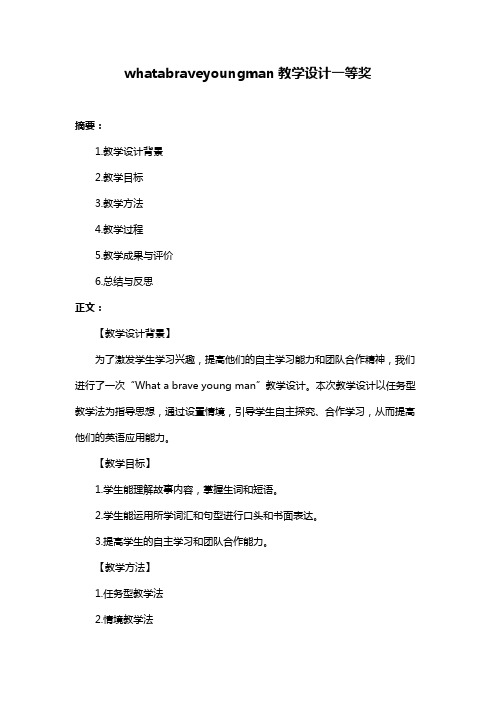
whatabraveyoungman教学设计一等奖摘要:1.教学设计背景2.教学目标3.教学方法4.教学过程5.教学成果与评价6.总结与反思正文:【教学设计背景】为了激发学生学习兴趣,提高他们的自主学习能力和团队合作精神,我们进行了一次“What a brave young man”教学设计。
本次教学设计以任务型教学法为指导思想,通过设置情境,引导学生自主探究、合作学习,从而提高他们的英语应用能力。
【教学目标】1.学生能理解故事内容,掌握生词和短语。
2.学生能运用所学词汇和句型进行口头和书面表达。
3.提高学生的自主学习和团队合作能力。
【教学方法】1.任务型教学法2.情境教学法3.小组合作学习【教学过程】1.引入话题:教师通过图片、问题等方式,激发学生的好奇心,引入本节课的话题。
2.词汇教学:教师教授本节课的重点词汇和短语,引导学生运用词汇进行口头表达。
3.阅读理解:学生分组,每组阅读故事的不同部分,然后向全班汇报。
在此过程中,教师给予指导,帮助学生理解故事内容。
4.语言运用:学生分组进行角色扮演,运用所学词汇和句型进行口头表达。
教师在此过程中进行点评和指导。
5.小组合作:学生分组,根据故事内容进行创意改编,然后在全班展示。
教师对各组的表演进行评价,并引导学生进行自我评价和反思。
【教学成果与评价】通过本次教学设计,学生的学习兴趣得到了激发,自主学习和团队合作能力得到了提高。
在教学评价中,学生表示喜欢这种新颖的教学方式,觉得更有参与感和成就感。
在教学成果方面,大部分学生能运用所学词汇和句型进行口头和书面表达,部分学生还能进行创意改编。
【总结与反思】本次教学设计取得了一定的成功,但也存在一些不足。
例如,在分组合作环节,部分学生的参与度不高,导致教学效果受到影响。
U7abraveyoungmanreading教学教材
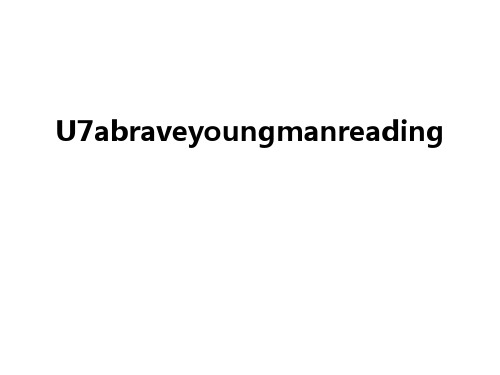
If there is a fire, what can we do?
We can pour water over the door. 倾倒 /pɔ:(r)/
If there is a fire, what should we do?
wet 湿的 /wet/
4.Put a wet hand-kerchief over your mouth and your nose to keep the smoke out.
If there is a fire, what should we do?
blanket 毯子 /ˊblæŋkɪt/
5. Rush out of the fire as quickly as you can. Pour some water over your clothes or use a wet blanket to protect you.
2. What did Lin Tao hear and see? He heard someone shouting “Fire! Fire! Help!” and saw a lot of smoke from next door.
3. Why couldn’t Mrs Sun get out of the kitchen? Because her left leg was badly hurt.
Careful reading
Read and answer
1. Did Lin Tao go out on 10 May? 2. What did Lin Tao hear and see? 3. Why couldn’t Mrs Sun get out of the
七年级英语A brave young man课件
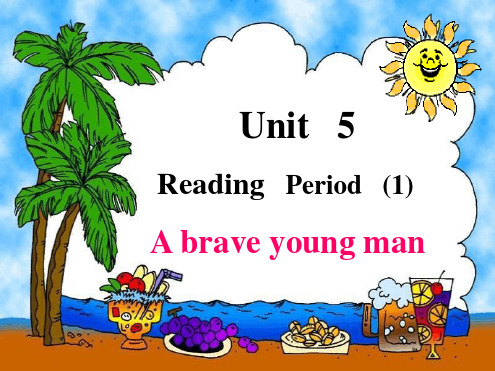
5. Keep your long hair away from the fire. 6. No smoking in the forest( 森林).
Safety is above all! 安全高于一切!
Proverb
To help others is to help ourselves! 帮助别人就是帮助自己!
Homework Choose one to do! 1.You are a radio host. Please interview Zhang Hua. 2.You are a policeman. Please write a report on Zhang Hua.
Task 6: Have a talk How do we learn from Zhang Hua?
When you find your classmate ill at school… When you see someone hurt in the street … When you see a little child lose his way …
May.
2. Mrs Sun was in her bedkritocohmenwhen the fire started.
3. Zhang Hua put out the fire with a blanket.
4. Zhang Hua was in hospital because the fire burned his lengesc.k, arms and face.
Unit 5
Reading Period (1)
最新语文A版小学语文四年级上册《勇敢的少年》教案第二课时(精品)
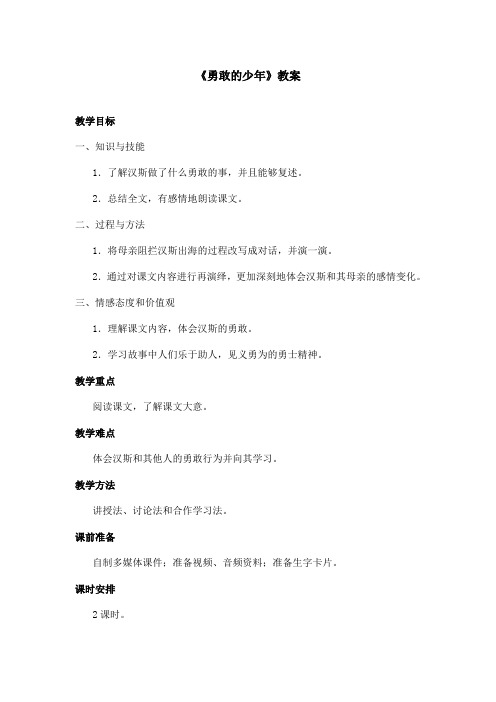
《勇敢的少年》教案教学目标一、知识与技能1.了解汉斯做了什么勇敢的事,并且能够复述。
2.总结全文,有感情地朗读课文。
二、过程与方法1.将母亲阻拦汉斯出海的过程改写成对话,并演一演。
2.通过对课文内容进行再演绎,更加深刻地体会汉斯和其母亲的感情变化。
三、情感态度和价值观1.理解课文内容,体会汉斯的勇敢。
2.学习故事中人们乐于助人,见义勇为的勇士精神。
教学重点阅读课文,了解课文大意。
教学难点体会汉斯和其他人的勇敢行为并向其学习。
教学方法讲授法、讨论法和合作学习法。
课前准备自制多媒体课件;准备视频、音频资料;准备生字卡片。
课时安排2课时。
第2课时。
教学过程一、导入新课讲新课之前,同学们先读一遍文章,使用“手机”录音,收集学生典型成果,在“授课”系统中展示。
同学们,上节课我们认识了一个勇敢的少年——汉斯,当他得知还有一个人留在岛上,等待他们去救援的时候他是怎么做的?后来发生了什么事?这节课,我们就继续来学习《勇敢的少年》。
二、新课学习(一)认读生字词,导入新课。
1.教师出示本课的生字新词,大家一起读一读,巩固认知。
2.有感情地朗读第1、2自然段。
3.教师导读:通过上节课的学习,我们知道人们冒着生命危险援救遇险的船只,第一次救援顺利地完成了,可是还有一个人正等待第二次救援。
这时,人们的心情“刚才还欢欣鼓舞的人们,顿时又陷入不安之中,才落下的心,又悬到了嗓子眼儿。
”救援队长开始组织另一支自愿救援队。
这支队伍与上一支有什么不同?(这支是自愿的,临时组织的,而上一支是早已组织好的。
)(二)继续学习课文,体会汉斯的勇敢。
1.师:这时发生了什么?(十六岁的汉斯自告奋勇地报了名。
)(自告奋勇:指汉斯主动地要求承担参加救援这项艰难的任务。
十六岁的汉斯还是一个未成年少年,他还是个孩子,他没有这个义务,也没有要求让他参加救援这项艰难的任务,可是他却勇敢地承担这个任务。
)2.他的母亲是怎样劝阻他的?为什么要阻止他?(他的母亲抓住他的胳膊,用颤抖的声音说:“汉斯,你不要去……”因为他的父亲死于海难,哥哥出海没有消息,母亲不希望他也出事。
七年级英语A-brave-young-man课件
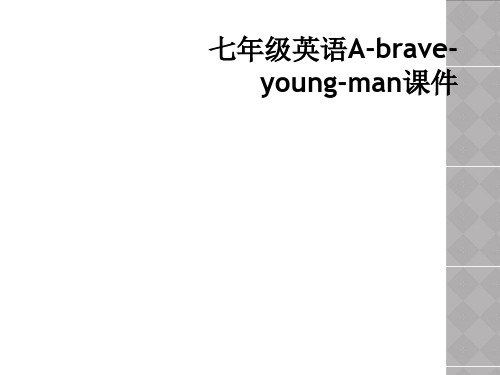
Proverb
To help others is to help ourselves! 帮助别人就是帮助自己!
Homework Choose one to do! 1.You are a radio host. Please interview Zhang Hua. 2.You are a policeman. Please write a report on Zhang Hua.
5. Many people visited Zhang Hua and gave him mflouwcherms aonndeypresents.
Task 3: Scan again, try to answer these questions.
1. When did the fire happen?
May.
2. Mrs n the fire started.
3. Zhang Hua put out the fire with a blanket.
4. Zhang Hua was in hospital because the fire burned his lneegcsk. , arms and face.
( For two months.)
5. What do you think about the young man?
( He was brave and helpful.)
Task4: Put them into the right order.
a2. hear someone shouting ‘Fire! Fire!’ b4. run back to her flat c8. help her out of the fire d6. rush into the kitchen e3. see a lot of smoke from next door f9. be in hospital for two months g1. be at home alone h5. pour water over the jacket i7. put out the fire with a blanket
四年级语文上册《勇敢的少年》教案 语文A版
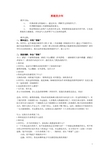
勇敢的少年教学目标:1、在熟读课文的基础上,通过对话,理解含义深刻的句子。
2、在理解的基础上有感情地朗读课文。
3、体会帮助别人是每个人的责任和义务,即便要面临危险也在所不辞,它也是勇敢的力量源泉,并体会与人为善等于与己为善的道理。
教学过程:一,整体读文,寻找“勇敢”师:同学们,这节课我们继续学习第27课。
(齐读课题《勇敢的少年》)通过上节课的学习,我们知道勇敢的少年是谁呢?(汉斯)那么你从课文哪些地方能感受到汉斯的勇敢呢?请同学们自由朗读课文,找出这些表现汉斯勇敢的句子,做上记号!二,朗读理解,体会“勇敢”句1:那是一个漆黑的夜晚,海面上乌云翻滚,狂风怒吼,一条渔船在巨浪中颠簸,船舱已经进水了。
船员的生命危在旦夕。
他们发出了紧急求救信号。
1指名读2同学们,说说句中哪些词语给你留下了深刻的印象?漆黑的夜晚,乌云翻滚,狂风怒吼,危在旦夕3读词语4你从这些词语感受到了什么?大海的凶险(相机板书危险)情势的危急时间紧急,相机指名读5同学们,其实这样的现象,就是海啸,海啸真的有如作者所描述的那样恐怖吗?还是让我们一起来观看一段视频吧!6说说你看后有什么感受?7女生读,男生读,多么可怕的海啸,多么危急的情势啊!全班同学,把我们的感受送进去,再读!总结:同学们,漆黑的夜晚,突如其来的海难让船员的生命危在旦夕,在这样的情况下,有了我们的第一次救援行动,幸运地是,大多数的人都被救回来了,村民们喜出望外,但救援队长却告诉大家还有一个遇险的人由于救援船太小而需要第二次救援时,刚才还欢欣鼓舞的人们,顿时又陷入不安之中,才落下的心,又悬到了嗓子眼儿。
这时,救援队长开始组织另一支自愿救援队。
在这紧急关头,汉斯是怎么做的呢?十六岁的汉斯自告奋勇报了名!句2:汉斯自告奋勇报了名。
1谁来说说自告奋勇是什么意思2指名说3同学们,在当时的情况下,参加海上救援意味着什么?4一个在海边成长的孩子,知不知道海浪足以吞噬生命?一个体验过海难痛苦的人,明不明白忧心忡忡的背后是生死未卜的命运?可是,在这紧急关头,16岁的少年(汉斯)并没有退缩,他不怕危险,(自告奋勇报了名)。
江苏省淮安市金湖县吕良中学七年级英语《Unit5Abraveyoungman》教案grammar2
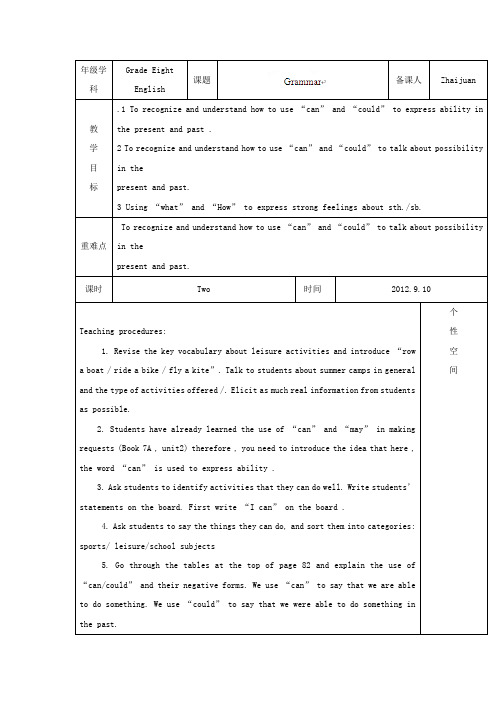
年级学科Grade EightEnglish课题备课人Zhaijuan教学目标.1 To recognize and understand how to use “can” and “could” to express ability in the present and past .2 To recognize and understand how to use “can” and “could” to talk about possibility in thepresent and past.3 Using “what” and “How” to express strong feelings about sth./sb.重难点To recognize and understand how to use “can” and “could” to talk about possibility in thepresent and past.课时Two 时间2012.9.10Teaching procedures:1. Revise t he key vocabulary about leisure activities and introduce “rowa boat / ride a bike / fly a kite”. Talk to students about summer camps in general and the type of activities offered /. Elicit as much real information from students as possible.2. Studen ts have already learned the use of “can” and “may” in making requests (Book 7A , unit2) therefore , you need to introduce the idea that here , the word “can” is used to express ability .3. Ask students to identify activities that they can do well. Wr ite students’ statements on the board. First write “I can” on the board .4. Ask students to say the things they can do, and sort them into categories: sports/ leisure/school subjects5. Go through the tables at the top of page 82 and explain the use of “can/could” and their negative forms. We use “can” to say that we are able to do something. We use “could” to say that we were able to do something in the past. 个性空间。
Abraveman说课稿
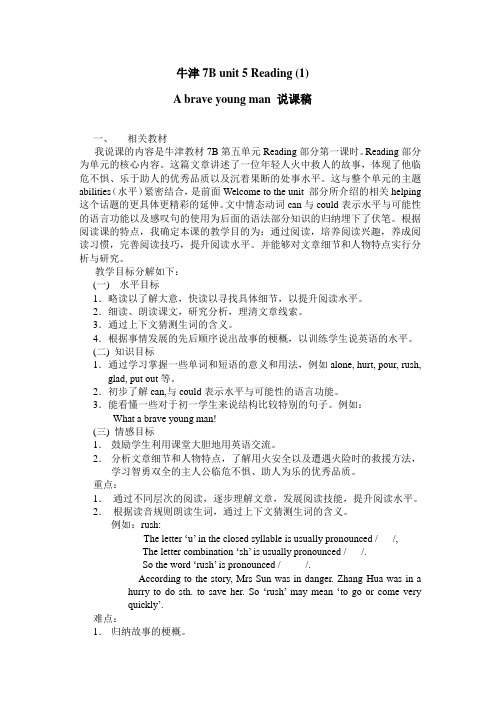
牛津7B unit 5 Reading (1)A brave young man 说课稿一、相关教材我说课的内容是牛津教材7B第五单元Reading部分第一课时。
Reading部分为单元的核心内容。
这篇文章讲述了一位年轻人火中救人的故事,体现了他临危不惧、乐于助人的优秀品质以及沉着果断的处事水平。
这与整个单元的主题abilities(水平)紧密结合,是前面Welcome to the unit 部分所介绍的相关helping 这个话题的更具体更精彩的延伸。
文中情态动词can与could表示水平与可能性的语言功能以及感叹句的使用为后面的语法部分知识的归纳埋下了伏笔。
根据阅读课的特点,我确定本课的教学目的为:通过阅读,培养阅读兴趣,养成阅读习惯,完善阅读技巧,提升阅读水平。
并能够对文章细节和人物特点实行分析与研究。
教学目标分解如下:(一)水平目标1.略读以了解大意,快读以寻找具体细节,以提升阅读水平。
2.细读、朗读课文,研究分析,理清文章线索。
3.通过上下文猜测生词的含义。
4.根据事情发展的先后顺序说出故事的梗概,以训练学生说英语的水平。
(二) 知识目标1.通过学习掌握一些单词和短语的意义和用法,例如alone, hurt, pour, rush, glad, put out等。
2.初步了解can,与could表示水平与可能性的语言功能。
3.能看懂一些对于初一学生来说结构比较特别的句子。
例如:What a brave young man!(三) 情感目标1.鼓励学生利用课堂大胆地用英语交流。
2.分析文章细节和人物特点,了解用火安全以及遭遇火险时的救援方法,学习智勇双全的主人公临危不惧、助人为乐的优秀品质。
重点:1.通过不同层次的阅读,逐步理解文章,发展阅读技能,提升阅读水平。
2.根据读音规则朗读生词,通过上下文猜测生词的含义。
例如:rush:The letter ‘u’ in the closed syllable is usually pronounced / /,The letter combination ‘sh’ is usually pronounced / /.So the word ‘rush’ is pronounced / /.According to the story, Mrs Sun was in danger. Zhang Hua was in ahurry to do sth. to save her. So ‘rush’may mean ‘to go or come veryquickly’.难点:1.归纳故事的梗概。
初中七年级英语教案Reading 1 A brave young man得奖
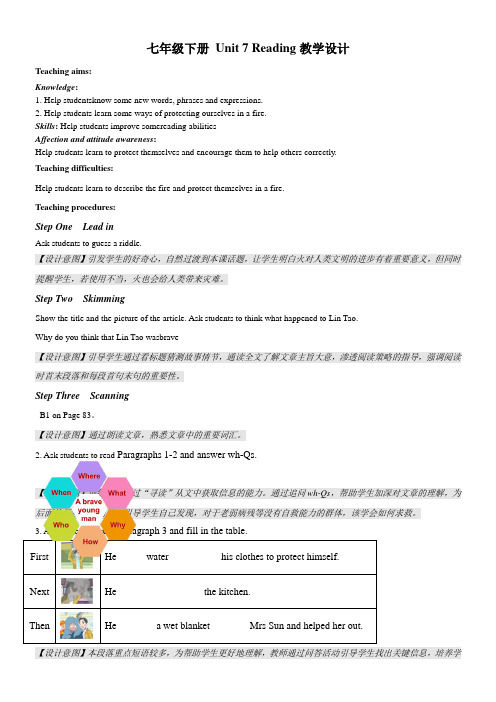
七年级下册Unit 7 Reading教学设计Teaching aims:Knowledge:1. Help studentsknow some new words, phrases and expressions.2. Help students learn some ways of protecting ourselves in a fire.Skills: Help students improve somereading abilitiesAffection and attitude awareness:Help students learn to protect themselves and encourage them to help others correctly.Teaching difficulties:Help students learn to describe the fire and protect themselves in a fire.Teaching procedures:Step One Lead inAsk students to guess a riddle.【设计意图】引发学生的好奇心,自然过渡到本课话题,让学生明白火对人类文明的进步有着重要意义,但同时提醒学生,若使用不当,火也会给人类带来灾难。
Step Two SkimmingShow the title and the picture of the article. Ask students to think what happened to Lin Tao.Why do you think that Lin Tao wasbrave【设计意图】引导学生通过看标题猜测故事情节,通读全文了解文章主旨大意,渗透阅读策略的指导,强调阅读时首末段落和每段首句末句的重要性。
Step Three ScanningB1 on Page 83。
七年级英语A-brave-young-man课件2
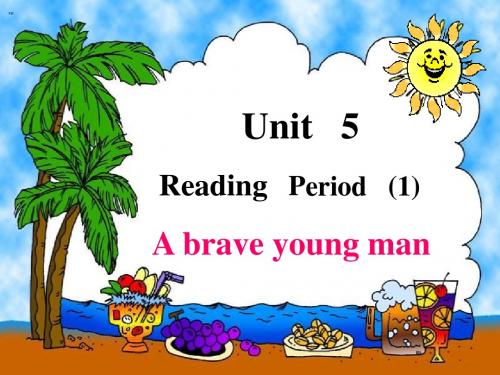
Task 5: Fire safety 1. You can throw a cigarette end (烟蒂) on the grass. 2. Be careful when you use candles (蜡烛) at home。 3. When there is a lot of smoke in the room, you should run out quickly. 4. If a fire happens, you should call 117 at once. 5. Keep your long hair away from the fire. 6. No smoking in the forest(森林).
May. 2. Mrs Sun was in her bedroom kitchen when the fire started. 3. Zhang Hua put out the fire with a blanket. 4. Zhang Hua was in hospital because the fire burned his legs. neck, arms and face.
( It happened on 10th May.)
2. How old was Mrs Sun?
( She was 79 years old.)
3. Why couldn’t Mrs Sun run out by herself?
( Because she hurt her leg.)
4. How long was the young man in hospital?
Safety is above all! 安全高于一切!
Task 6: Have a talk
whatabraveyoungman教学设计一等奖
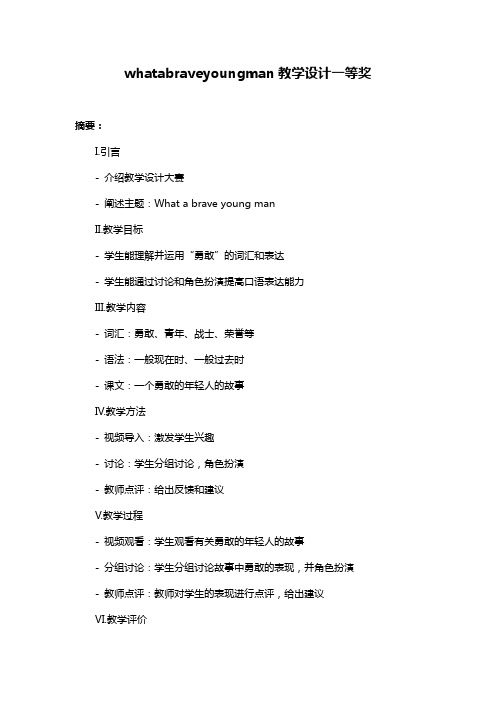
whatabraveyoungman教学设计一等奖摘要:I.引言- 介绍教学设计大赛- 阐述主题:What a brave young manII.教学目标- 学生能理解并运用“勇敢”的词汇和表达- 学生能通过讨论和角色扮演提高口语表达能力III.教学内容- 词汇:勇敢、青年、战士、荣誉等- 语法:一般现在时、一般过去时- 课文:一个勇敢的年轻人的故事IV.教学方法- 视频导入:激发学生兴趣- 讨论:学生分组讨论,角色扮演- 教师点评:给出反馈和建议V.教学过程- 视频观看:学生观看有关勇敢的年轻人的故事- 分组讨论:学生分组讨论故事中勇敢的表现,并角色扮演- 教师点评:教师对学生的表现进行点评,给出建议VI.教学评价- 学生自我评价:学生对自己的表现进行评价- 教师评价:教师对学生的表现进行总结和评价VII.结论- 总结教学设计大赛的收获- 强调勇敢品质的重要性正文:本次教学设计大赛的主题是“What a brave young man”。
在这个教学设计中,我旨在帮助学生理解并运用“勇敢”的词汇和表达,并通过讨论和角色扮演提高学生的口语表达能力。
教学目标是使学生能理解并运用“勇敢”的词汇和表达,以及通过讨论和角色扮演提高口语表达能力。
为了实现这一目标,我选择了词汇:勇敢、青年、战士、荣誉等,以及语法:一般现在时、一般过去时。
通过课文:一个勇敢的年轻人的故事,使学生更好地理解勇敢的含义。
在教学过程中,我首先通过视频导入,激发学生的兴趣。
然后,学生分组讨论故事中勇敢的表现,并进行角色扮演。
最后,我给出反馈和建议,帮助学生提高口语表达能力。
在教学评价方面,我鼓励学生进行自我评价,以便他们了解自己在学习过程中的优点和不足。
同时,我也对学生的表现进行总结和评价,以便他们更好地了解自己的进步。
总之,通过这次教学设计大赛,我收获颇丰。
七年级英语A brave young man课件ppt
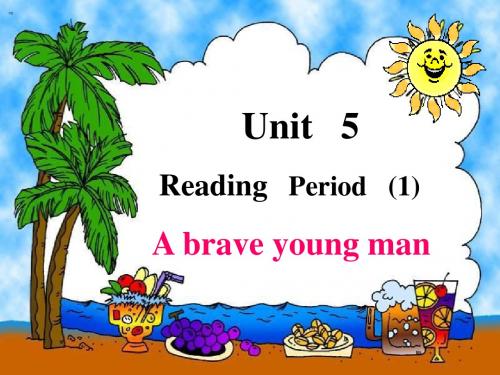
Proverb
To help others is to help ourselves! 帮助别人就是帮助自己!
Homework Choose one to do! 1.You are a radio host. Please interview Zhang Hua. 2.You are a policeman. Please write a report on Zhang Hua.
( For two months.)
5. What do you think about the young man?
( He was brave and helpful.)
Task4: Put them into the right order.
a2. hear someone shouting ‘Fire! Fire!’ b4. run back to her flat c8. help her out of the fire d6. rush into the kitchen e3. see a lot of smoke from next door f9. be in hospital for two months g1. be at home alone h5. pour water over the jacket i7. put out the fire with a blanket
Task 6: Have a talk How do we learn from Zhang Hua?
When you find your classmate ill at school… When you see someone hurt in the street … When you see a little child lose his way…
江苏省宿迁市宿豫区2012年秋七年级英语上册《 Unit5 A brave young man !
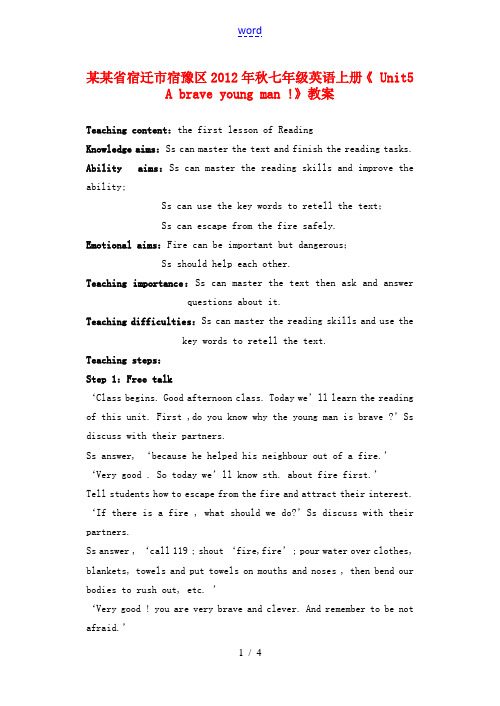
某某省宿迁市宿豫区2012年秋七年级英语上册《 Unit5A brave young man !》教案Teaching content:the first lesson of ReadingKnowledge aims:Ss can master the text and finish the reading tasks. Ability aims:Ss can master the reading skills and improve the ability;Ss can use the key words to retell the text;Ss can escape from the fire safely.Emotional aims:Fire can be important but dangerous;Ss should help each other.Teaching importance:Ss can master the text then ask and answerquestions about it.Teaching difficulties:Ss can master the reading skills and use thekey words to retell the text.Teaching steps:Step 1:Free talk‘Class begins. Good afternoon class. Today we’ll learn the reading of this unit. First ,do you know why the young man is brave ?’Ss discuss with their partners.Ss answer, ‘because he helped his neighbour out of a fire.’‘Very good . So today we’ll know sth. about fire first.’Tell students how to escape from the fire and attract their interest. ‘If there is a fire , what should we do?’Ss discuss with their partners.Ss answer , ‘call 119 ; shout ‘fire,fire’; pour water over clothes, blankets, towels and put towels on mouths and noses , then bend our bodies to rush out, etc. ’‘Very good ! you are very brave and clever. And remember to be not afraid.’Step 2 :Fire drillThe teacher ask, ‘do you remember we held a fire drill last year ?’Ss say , ‘yes’ . ‘Last time , all of you did very well . So now we’ll have a fire drill again . I hope all of you will be safe if there’s a fire , Ok?’‘Are you ready for the fire drill?’’Good , let’ begin.’Ss rushed out of the classroom one by one . But one boy hurt his leg. Then another boy helped him out of the fire .Then Ss came back. ‘Do you know what happened to Bo Lulei just now?’‘Yes’, ‘What happened?’‘He hurt his leg and Zhu Shunqiang helped him out.’‘Very good. What will you say to Zhu Shunqiang?’ Ss discuss with their partners.‘Zhu Shunqiang, you are very brave and helpful, thank you ’;‘Zhu Shunqiang, you are very great , we should learn from you.’,etc. ‘OK, very good . you are very great and Zhu Shunqiang is better. We should learn from him . we should help others.’Step 3 :Listen‘Now we will meet a new friend . He is also very help and brave .Do you want to meet him?’Listen to the tape and ask the students to answer two easy questions. To get the general idea of the text.Step 4 :Independent study & Detail- reading‘Now next please read the passage by yourselves loudly’.Ss read the passage freely and then finish the tasks. Ss discuss with their partners first.Ex.1:Put them into the right order.Ex.2: Fill in the table.‘Then do you find the red words ? What are they ?They are all ‘Wh-’words. Very good’.‘Now we’ll learn the reading skills. Present the reading skills. Ss read it together’.Step 5: Cooperative study & ConsolidationWork in 4 groups to have a petition. Ss read the passage carefully and ask ‘Wh-‘questions as many as possible. Ss discuss with their partners in the same group.Then Ss ask the questions actively and the others can answer them quickly .This task can help Ss talk in class bravely and help them master the text.‘I still can’t find which group is better because all of you are great. Let’s go on another task, OK?’Step 6:Use key words to tell the story‘Do you remember the content we learnt last unit? It’s about the Simple Past Tense. And we should pay more attention to the verbs. Right?’Show the key words of Para.1 then students learn to find the key words of the rest by themselves. Ss discuss with their partners.Use key words(关键词) to tell the storyLine 1—12:1. helped…(out of)…2. was…3. heard…shouting…4. ran …5. saw…(smoke)…6. went in …7. saw …8. could not..9. hurt..10. could happen to...4 groups remend 4 Ss to write the key words on the Bb. And the others retell the text.Step 7:Make an interviewword‘A reporter is also interested in the story. He/She wants to make an interview. Please work in small groups of two or three’. Ss discuss with their partners.Review the text by making an interview .Then two groups give the show.Step 8:Discussion & Conclusion‘What do we learn from Zhang Hua ? we should be brave and helpful. About fire. Fire is important and useful but dangerous’.Ss discuss with their partners.Step 9:Award for the winnerAt last , the winner appears. Then an award for them.Step 10: Homework1. Read the story at least 3 times.2. To underline what you can’tunderstand .3. To tell more people to help each other.。
- 1、下载文档前请自行甄别文档内容的完整性,平台不提供额外的编辑、内容补充、找答案等附加服务。
- 2、"仅部分预览"的文档,不可在线预览部分如存在完整性等问题,可反馈申请退款(可完整预览的文档不适用该条件!)。
- 3、如文档侵犯您的权益,请联系客服反馈,我们会尽快为您处理(人工客服工作时间:9:00-18:30)。
牛津7B unit 5 Reading (1)A brave young man 说课稿一、有关教材我说课的内容是牛津教材7B第五单元Reading部分第一课时。
Reading部分为单元的核心内容。
这篇文章讲述了一位年轻人火中救人的故事,体现了他临危不惧、乐于助人的优秀品质以及沉着果断的处事能力。
这与整个单元的主题abilities(能力)紧密结合,是前面Welcome to the unit 部分所介绍的有关helping 这一话题的更具体更精彩的延伸。
文中情态动词can与could表示能力与可能性的语言功能以及感叹句的使用为后面的语法部分知识的归纳埋下了伏笔。
根据阅读课的特点,我确定本课的教学目的为:通过阅读,培养阅读兴趣,养成阅读习惯,完善阅读技巧,提高阅读能力。
并能够对文章细节和人物特点进行分析与研究。
教学目标分解如下:(一)能力目标1.略读以了解大意,快读以寻找具体细节,以提高阅读能力。
2.细读、朗读课文,研究分析,理清文章线索。
3.通过上下文猜测生词的含义。
4.根据事情发展的先后顺序说出故事的梗概,以训练学生说英语的能力。
(二) 知识目标1.通过学习掌握一些单词和短语的意义和用法,例如alone, hurt, pour, rush, glad, put out等。
2.初步了解can,与could表示能力与可能性的语言功能。
3.能看懂一些对于初一学生来说结构比较特别的句子。
例如:What a brave young man!(三) 情感目标1.鼓励学生利用课堂大胆地用英语交流。
2.分析文章细节和人物特点,了解用火安全以及遭遇火险时的救援方法,学习智勇双全的主人公临危不惧、助人为乐的优秀品质。
重点:1.通过不同层次的阅读,逐步理解文章,发展阅读技能,提高阅读能力。
2.根据读音规则朗读生词,通过上下文猜测生词的含义。
例如:rush:The letter …u‟ in the closed syllable is usually pronounced / /,The letter combination …sh‟ is usually pronounced / /.So the word …rush‟ is pronounced / /.According to the story, Mrs Sun was in danger. Zhang Hua was in ahurry to do sth. to save her. So …rush‟may mean …to go or come veryquickly‟.难点:1.归纳故事的梗概。
2.分清can与could表示能力与可能性的不同用法。
例如:She could not get out because she hurt her leg.…Could” here is used to talk about ability.Anything could happen to her at that moment.…Could‟ in this sentence is used to talk about possibility.3.理解、分析一些结构比较特别的句子。
!)He went in and saw his neighbour, the 79-year-old Mrs Sun, in the kitchen.此句中,学生需要了解the 79-year-old Mrs Sun为his neighbour的同位语。
同时,还需要掌握79-year-old这个复合形容词的构成和作定语的用法。
2)Zhang Hua was glad that he helped Mrs Sun.此句中,学生应该了解that在这里没有意义,是连接词,引导一宾语从句。
3)What a brave young man!根据句子使用的目的,句子可分为四类。
这是其中之一:感叹句。
学生应了解由What引出的感叹句的基本结构。
4)It is important to be careful with fire.此句中,学生应理解it在此为形式主语,真正的主语为动词不定式短语to be careful with fire。
此句为主语+连系动词+表语的句型。
二、有关教法处理这堂课的过程中,我将时刻遵循教师为主导,学生为主体的原则,开展教学活动。
另外,我将结合文章,引导学生在学习语言的同时受到德育教育。
我采用的教法之一为读书指导法。
指导学生跟随老师提出的任务通过阅读文章来寻求答案,调动学生学习的主动性,培养他们认真读书和独立思考的习惯。
我采用的另一教法为谈话法。
语言的主要功能在于交际。
通过问答可以激发学生的思维活动,有利于发展学生的语言表达能力。
在教学过程中,我除了使用录音机和黑板之外,还将利用多媒体来帮助解决重点难点,拓展学生的知识面,丰富教学内容和形式,提高课堂教学效率。
三、有关学法“未来的文盲不再是不识字的人,而是不会学习的人。
”现代教育强调学生要学会学习。
在本课中,学生需要通过看,读,想,说来理解文章的大意与内涵,还需要发扬合作精神,在与他人互帮互助,取长补短的过程中解决问题并报告结果,共同较为完满地完成学习任务,让自己在听、说、读、写,尤其是读这一方面得到充分的训练。
四、有关教学过程Step1. Lead-in人们常说一篇好作文由凤头、猪肚和豹尾组成。
我想课堂教学也是如此。
“凤头”即是要求一节课的开头突兀有新意,扣人心弦,吸引学生的注意力,使学生产生强烈的学习热情和兴趣,迫不及待地想要去读文章。
我打算以一则谜语导入新课:I‟m always hungry,I must always be fed,The finger I lickWill soon turn red.学生得出谜底后,我会说:Fire is very useful in our life. What can it do for us? Do you know? 接着我将呈现一些图片,让学生谈谈火的用处。
例如,It can cook food. It can make our houses warm. It can make water hot. It can give light…随后,我会问:Is fire always useful? 学生一定会异口同声给我一个否定的答案。
我顺势引入文章:You are right. Sometimes fire can also be very dangerous. Now here‟s a newspaper article on page 78 in your books. Let‟s read a story that happened in a dangerous fire. 按照新课程标准的要求,阅读前不必要简述或呈现文章的内容,这有利于阅读能力的培养。
所以,我在导入部分暂时不对火的危害性展开任何讨论与陈述。
Step 2. Skimming要求学生略读文章,然后回答问题:What is this newspaper article about?(Tha article tells us how Zhang Hua helped his neighbour out of a fire.)Step 3. Scanning新课标要求学生在略读skim之后能带着问题scan for details, 提高快速捕捉所需要的信息的能力。
虽然此时生词还没有解决,但是在实际生活中,阅读中几乎总是存在生词的。
我给学生设置了以下问题:1.Where was Mrs Sun when the fire happened?2.What did he put out the fire with?3.How long was he in hospital?Step 4. Careful reading在这个环节中,学生需要完成以下任务::1.根据语音规则,试着读出pour, alone, rush等生词,并根据上下文, 猜测这些生词的词义。
这有助于提高学生认读单词,运用和记忆单词的能力,而不是死记硬背。
2.试着理解一些短语,如:put out,happen to sb.,in hospital等等。
3.注意含有can 与could的句子,辨别他们在不同句中的表示能力或可能性的不同语言功能。
4.尝试分析、理解以下句子:!)He went in and saw his neighbour, the 79-year-old Mrs Sun, in the kitchen.2)Zhang Hua was glad that he helped Mrs Sun.3)What a brave young man!4) It is important to be careful with fire.5.给文章分段,并归纳段落大意。
本课是新闻报导,根据文体的特点,我指导学生把文章分为三个段落:第一段(第1小节):简述张华救人的事实。
第二段(2 - 4小节):详细介绍张华救人的经过。
第三段(5、6小节):张华的感受。
我认为学习语言一定要落实到语篇上。
篇章不是杂乱无章的,而是讲究一定的叙述顺序和条理的,要求学生理清线索,分清层次,有助于写作能力的培养。
在个人思考的基础上,我会鼓励学生就某些难点:例如can与could的语言功能,几个难句的分析与理解进行合作学习,让他们互相帮助,共同寻求更加准确又完整的答案。
最后,我还会鼓励学生提出文章内容的理解方面还存在的疑惑,师生共同讨论,扫除障碍。
6.随后我将提供一些问题,让学生以谈话的方式来检测对于文章的理解。
Questions:1) When did the fire happen?2) Who was with Zhang Hua at home?3) What did he hear suddenly?4) What did he see?5) Why couldn‟t Mrs. Sun get out?6) Did he rush into Mrs. Sun‟s kitchen at once?7) Why did he pour water over his flat?8) Did Zhang Hua run out of the building?9) Did the fire burn Zhang Hua?10) Was he in hospital for three months?11) Who visited him and what did they bring him?12) Do you think Zhang Hua will help others next time?Why do you think so?Step5. Reading aloud朗读可以说是一项十分重要的基本功, 在指导学生朗读的过程中, 除了关注学生的语音语调之外, 我会注重在失去爆破,不完全爆破,连读,重读与节奏等阅读技巧方面的指导。
